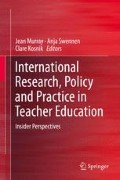Abstract
This chapter reports on a study of 28 literacy/English teacher educators in 4 countries (Canada, the USA, Australia, and England) with a focus on their use of digital technology. For analyzing the data, we used Ottenbreit-Leftwich et al.’s (2010) six different ways to incorporate technology into teacher education: information delivery, hands-on skill-building activities, practice in the field, observations and modeling, authentic experiences, and reflections (p. 20). Although most felt using digital technology in teacher education is very important, there were huge differences in how they used it. A few reconceptualized their courses to teach about, with, and through it, while others only used it mainly for information delivery. Two major challenges identified by most were that their university only provided limited support and mostly for technical problems (not pedagogical support) and that student teachers were not necessarily discerning users of resources on the web.
We wish to thank the Social Sciences and Humanities Research Council of Canada for their generous support of this research.
Access this chapter
Tax calculation will be finalised at checkout
Purchases are for personal use only
Notes
- 1.
Pseudonyms used for all participants
References
Barrett, M. D., & Mascia, E. G. (2012). Teacher response: Professional development to reconceptualize literacy instruction. In D. Alvermann & K. Hinchman (Eds.), Reconceptualizing the literacies in adolescents’ lives: Bridging the everyday/academic divide (pp. 264–269). New York: Routledge.
Bennett, S., Maton, K., & Kervin, S. (2008). The ‘digital natives’ debate: A critical review of the evidence. British Journal of Educational Technology, 39(5), 775–786.
Bullock, S. (2011). Teaching 2.0: (re)learning to teach online. Interactive Technology and Smart Education, 8(2), 94–105.
Bullock, S. (2016). Issues regarding digital technology in education. In C. Kosnik, S. White, C. Beck, B. Marshall, L. Goodwin, & J. Murray (Eds.), Building bridges: Rethinking literacy teacher education in a digital era (pp. 3–16). Rotterdam: Sense Publishers.
Butler, D. L., & Sellbom, M. (2002). Barriers to adoption of technology for teaching and learning. Educause Quarterly, 25(2), 22–28.
Cervetti, G., Damico, J., & Pearson, P. D. (2008). Multiple literacies, new literacies, and teacher education. Theory Into Practice, 45(4), 378–386.
Desjardins, F. (2005). La représentation par les enseignants, quant à leurs profils de compétences relatives à l’ordinateur: vers une théorie des TIC en éducation. La Revue Canadienne de L’apprentissage et de La Technologie, 31(1), 27–49.
Freebody, P. (2007). Literacy education in school. Research perspectives from the past, for the future. Camperbell: Australian Council for Education Research.
Garcia-Matin, J., Merchant, G., & Garcia-Sanchez, J. (2016). Preparing to teach 21st century literacies). In C. Kosnik, S. White, C. Beck, B. Marshall, L. Goodwin, & J. Murray (Eds.), Building bridges: Rethinking literacy teacher education in a digital era (pp. 43–55). Rotterdam: Sense Publishers.
Kosnik, C., & Dharamshi, P. (2016). In C. Kosnik, S. White, C. Beck, B. Marshall, L. Goodwin, & J. Murray (Eds.)., Building bridges: Rethinking literacy teacher education in a digital era Goals and practices of seven literacy teacher educators in four countries who have integrated digital technology into their literacy teacher education courses. Rotterdam: Sense Publishers.
Marshall, B. (2016). Multi modalities in literacy/English education courses). In C. Kosnik, S. White, C. Beck, B. Marshall, L. Goodwin, & J. Murray (Eds.), Building bridges: Rethinking literacy teacher education in a digital era. Rotterdam: Sense Publishers.
Merriam, S. (2009). Qualitative research: A guide to design and implementation. San Francisco: Jossey-Bass.
Otero, V., Peressini, D., Meymaris, K., Ford, P., Garvin, T., Harlow, D., Reidel, M., Waite, B., & Mears, C. (2005). Integrating technology into teacher education: A critical framework for implementing reform. Journal of Teacher Education, 56(1), 8–23.
Prensky, M. (2011). Digital wisdom and homo sapiens digital. In M. Thomas (Ed.), Deconstructing digital natives: Young people, technology and the new literacies (pp. 15–29). New York: Routledge.
Punch, K. (2014). Introduction to social research: Quantitative and qualitative approaches. London: Sage.
Selber, S. (2004). Multiliteracies in a digital age. Carbondale: Southern Illinois University Press.
Selwyn, N. (2011). In praise of pessimism – The need for negativity in educational technology. British Journal of Educational Technology, 42(5), 713–718.
Selwyn, N. (2012). Ten suggestions for improving academic research in education and technology. Learning Media and Technology, 37(3), 213–219.
Selwyn, N. (2013). Digital technologies in universities: Problems posing as solutions? Learning, Media and Technology, 38(1), 1–3.
Walsh, M., & Durant, C. (2013). Multiliteracies: A slow movement in literacy minor. In C. Kosnik, J. Rowsell, P. Williamson, R. Simon, & C. Beck (Eds.), Literacy teacher educators: Preparing student teachers for a changing world (pp. 175–190). Rotterdam: Sense Publishers.
Warschauer, M. (2011). Learning in the cloud: How (and why) to transform schools with digital media. New York: Teachers College Press.
White, S., & Murray, J. (2016). Fostering professional learning partnerships in literacy teacher education. In C. Kosnik, S. White, C. Beck, B. Marshall, L. Goodwin, & J. Murray (Eds.), Building bridges: Rethinking literacy teacher education in a digital era (pp. 135–148). Rotterdam: Sense Publishers.
Author information
Authors and Affiliations
Corresponding author
Editor information
Editors and Affiliations
Rights and permissions
Copyright information
© 2019 Springer Nature Switzerland AG
About this chapter
Cite this chapter
Kosnik, C., Dharamshi, P., Menna, L. (2019). From Tinkering Around the Edges to Reconceptualizing Courses: Literacy/English Teacher Educators’ Views and Use of Digital Technology. In: Murray, J., Swennen, A., Kosnik, C. (eds) International Research, Policy and Practice in Teacher Education. Springer, Cham. https://doi.org/10.1007/978-3-030-01612-8_5
Download citation
DOI: https://doi.org/10.1007/978-3-030-01612-8_5
Published:
Publisher Name: Springer, Cham
Print ISBN: 978-3-030-01610-4
Online ISBN: 978-3-030-01612-8
eBook Packages: EducationEducation (R0)

